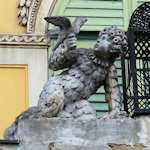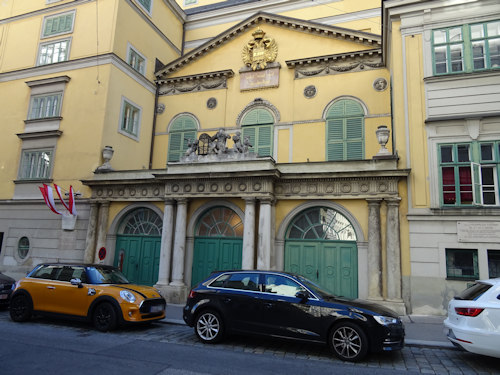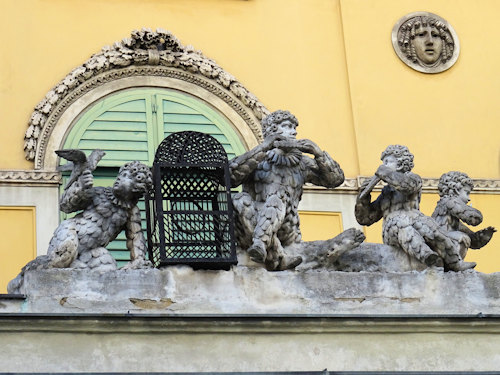
“As the birdcatcher I am known by old and young throughout the land.”
The words are sung by Papageno, a main character in Mozart’s 1791 opera, The Magic Flute. And the Papagenotor is a gateway that pays due respect to the role and, more particularly, the librettist who wrote the above words.
- Old main entrance to the Theater an der Wien
- Sculpted figures feature Papageno and the child spirits from The Magic Flute
- Book a concert experience* in Vienna
- See also:
An operatic gateway

(The gateway in its entirety)
In Mozart’s opera, Papageno accompanies the “hero” of the tale, Tamino, as they attempt to free Pamina, daughter of the Queen of the Night, from the clutches of the high priest Sarastro.
The two men undergo various trials, which Tamino masters. Papageno is somewhat more fallible, falling somewhere between hero and loser (like nearly all of us).
Emanuel Schikaneder wrote the libretto for Mozart and also performed as Papageno at the premiere. He would become closely associated with the role.
Not content with writing and performing, Schikaneder later added the words impresario and entrepreneur to his CV by founding the Theater an der Wien, which opened in 1801.

(The gate around 1822, as sketched by the famous artist Jakob Alt; Wien Museum Inv.-Nr. 105321; excerpt reproduced with permission under the terms of the CC0 licence)
The Papagenotor (English: “Papageno Gate”) is on the side of the building that runs along Millöckergasse and the Theater’s former main entrance. The name comes from the collection of sandstone statues mounted above the portal in a nod to Schikaneder.
In the portrayed scene, Papageno sits with his flute, cloaked in feathers and next to a small birdcage. The three child spirits who guide and help him and Tamino throughout the opera surround him. (Schikaneder’s niece, Anna, played one of the children at the premiere.)
The double eagle coat of arms that looks out over the gate from behind bears the inscription F. II.. This refers to Francis II, Holy Roman Emperor (though not for much longer) and ruler of the Habsburg lands at the time.

(The feathered fellow himself and friends)
The Theater an der Wien has a chequered history but is still going strong as the oldest of Vienna’s three great opera houses. Beethoven even lived in it briefly. Indeed, the Papagenotor sits opposite Hotel Beethoven on Papagenogasse. The street took its name from the famous theatre entrance in 1876.
How to get to the Papagenotor
The opera house with its thematic gate is quite central, close to the Naschmarkt open-air market.
This is Jugendstil architectural territory; near neighbours include, for example, Otto Wagner’s Majolikahaus and, most importantly, the Secession building with its notable white and gold design.
Subway: A short walk from the Museumsquartier station (line U2) or Karlsplatz station (lines U1, U2 and U4).
Bus: Line 59A (get off at Bärenmühldurchgang) or line 57A (get off at Getreidemarkt). Both stops are around 5 minutes walk away.
Address: The intersection of Millöckergasse/Papagenogasse, 1030 Vienna